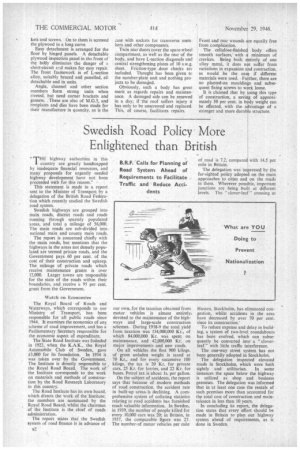Swedish Road Policy More Enlightened than British
Page 36

If you've noticed an error in this article please click here to report it so we can fix it.
" THE highway authorities in this country are greatly handicapped by inadequate financial resources, and many proposals for urgently needed highway development have not been proceeded with for this reason."
This statement is made in a report sent to the Minister of Transport by a delegation of the British Road Federation which recently studied the Swedish road system.
Swedish highways are grouped into main roads, district roads and roads running through sparsely populated areas, and total a mileage of 56,000. The main roads are sub-divided into national main and county main roads.
The report is concerned chiefly with the main roads, but mentions that the highways in the areas not densely populated are termed private roads, and the Government pays 60 per cent. of the cost of their construction and upkeep. The mileage of private roads which receive maintenance grants is over 12,000. Larger towns are responsible for the state of the roads within their boundaries, and receive a 95 per cent. grant from the Government.
Watch on Economies The Royal Board of Roads and Waterways, which corresponds to our Ministry of Transport, has been responsible for all public roads since 1944. It examines the economics of any scheme of road improvement, and has a Parliamentary Secretary responsible for the economic aspect of expenditure.
The State Road Institute was founded in 1922. when the K.A.K., the Royal Automobile Club of Sweden, gave £3,000 for its foundation. In 1934 it was taken over by the Government. The Institute is directly responsible to , the Royal Road Board. The work of' the Institute corresponds to the work on materials and methods of construction by the Road Research Laboratory in this country.
1 he. Road Institute has its own board, which directs the work of the Institute; the members are nominated by the Royal Road Board, whilst the chairman of the Institute is the chief of roads administration.
• The report states that the Swedish system of road finance is in advance of our own, for the taxation obtained from motor vehicles is almost entirely. devoted to the maintenance of the highways and large-scale construction schemes. During 1938-9 the total yield from taxation was 134,000,000 Kr., of which 84,000,000 Kr. was spent on maintenance, and 42,000,000 Kr: on major improvements and new roads.
On all vehicles the first 900 kilogs. of gross unladen weight is taxed at 70 Kr., and for every successive 100 kilogs. the tax is 20 Kr. for private cars, 25 Kr. for lorries, and 22 Kr. for buses. Petrol tax is about Is. per gallon.
On the subject of accidents, the report says that because of modern methods of road construction, the accident rate in built-up areasis declining. A comprehensive system of collating statistics relating to road accidents has furnished much valuable information. In Sweden. in 1939, the number of people killed for every 10,000 cars was 20: in Britain, in 1937, the comparable figure was 27. The number-of motor vehicles per mile of road is 7.2, compared with 14.5 per mile in Britain.
The delegation was. im ressed by the far-sighted policy adopted on the main approaches to cities and on the roads in them. Wherever possible, important junctions are being built at different levels. The clover-leaf" crossing at Hussen, Stockholm, has eliminated congestion, whilst accidents in the area have decreased by over 70 per cent. since its construction; To reduce expense and delay in building, a system of two-level roundabouts has been evolved, which can subsequently be converted into a " cloverleaf " with little traffic interference.
The one-way street system has not been generally adopted in Stockholm, The delegation inspected elevated roads in Stockholm, which were both sightly and utilitarian. In some instances the space below the highway is utilized as shop and business premises. The delegation was informed that in 'at least one case the rentals of such premises more than accounted for the total cost of construction and maintenance in less than 10 years.
In concluding its report, the delegation states that every effort should be made in Britain to plan our highway system ahead of requirements, as is done in Sweden.
























































































